![]()
![]()
![]()
Use LEFT and RIGHT arrow keys to navigate between flashcards;
Use UP and DOWN arrow keys to flip the card;
H to show hint;
A reads text to speech;
49 Cards in this Set
- Front
- Back
|
What are the stages of mitosis? |
Prophase, prometaphase, metaphase, anaphase, telophase, and cytokinesis. Interphase is not part of mitosis. |
|
|
What happens during interphase to prepare the cell for division? |
1. Cell size increases (G1) 2. Synthesis of proteins used in M phase (G2) 3. DNA replicates (S) 4. Centrosome duplicates (S) 5. Cohesin rings form on newly replicated chromosomes (S) |
|
|
What happens during prophase? |
1. Condensins cause loops of chromatin to condense, forming 5b level condensed DNA. 2. The interphase MT cytoskeleton collapses. 3. The mitotic spindle forms 4. Duplicated centrosomes separate. 5. Kinetochores form at centromeres. |
|
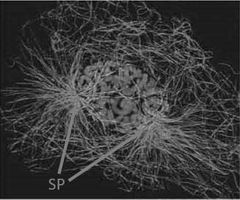
What is this an image of? |
A cell in prophase. |
|
|
What are spindle poles? |
Centrosomes become part of this larger structure as interpolar MTs (IP-MTs) connect to the 2 spindle poles and push them apart during prophase. |
|
|
What are astral MTs (a-MTs)? |
Microtubules that radiate out from the spindle poles during prophase, some associating with the plasma membrane/actin cell cortex. |
|
|
What are kinetochores? |
They form at chromosome centromeres during prophase. They are large protein complexes required for chromosome segregation. |
|
|
What happens during prometaphase? |
1. Nuclear lamins are phosphorylated, causing the nuclear envelope to collapse into vesicles. 2. Kinetochore MTs (kMTs) can now attach both spindle poles to each chromosome. |
|
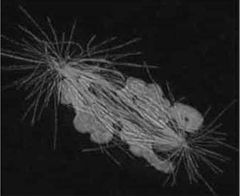
What is this an image of? |
A cell in prometaphase. |
|
|
What happens during metaphase? |
Chromosomes "congress," meaning they come together to align in the exact center of the cell (metaphase plate). K-MTs shorten on one side and lengthen on the other until they are equal and the chromosomes are centered. |
|

What is this an image of? |
A cell in metaphase. |
|
|
What happens during anaphase? |
1. Cohesin rings are destroyed, allowing segregation of sister chromatids (as separate chromosomes) to opposite poles (early role of Anaphase-promoting complex [APC]). 2. K-MTs shorten and IP-MTs elongate, leading to the segregation of chromosomes to opposite poles. 3. To exit anaphase, cyclin Ms are destroyed (Late role of APC). |
|
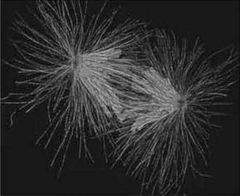
What is this an image of? |
A cell during anaphase. |
|
|
What is anaphase subdivided into? |
1. Anaphase A: chromosomes are pulled toward the poles 2. Anaphase B: poles are pushed and pulled apart by IP-MTs. These two phases occur at the same time. |
|
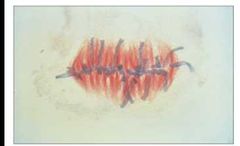
What is this an image of? |
Metaphase |
|
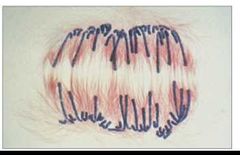
What is this an image of? |
Anaphase |
|
|
How are cohesin rings destroyed in anaphase? |
1. M-Cdk complex activates APC (also called APC/C) 2. APC catalyzes the ubiquitylation and destruction of an inhibitory protein called securin. 3. This releases the proteolytic enzyme, separase, which then cleaves the cohesin complexes 4. This allows the mitotic spindle to pull sister chromatids apart. |
|
|
What happens during telophase? |
1. Chromosomes arrive at the poles. 2. De-phosphorylation of Lamins by a phosphatase causes a nucleus to form at each pole. 3. Fusion of nuclear envelope vesicles. 4. Condensins are inactivated to release chromatin from the 5b level DNA packaging to the less condensed 5a level of DNA packaging. (Sausage-like to Cloud-like).
Cytokinesis begins during Telophase |
|

What is this an image of? |
A cell during telophase. |
|
|
What happens to the Golgi apparatus during mitosis? |
It is fragmented into vesicles and moved to poles via MT motors on spindle MTs. |
|
|
What forms a contractile ring that is required for cytokinesis following mitosis? |
Actin filaments and myosin-II protein. |
|
|
How do motor proteins and the mitotic spindle function? |
1. Kinesin 5 grabs IP-MT from both poles and slides them apart in prophase, separating spindle poles. 2. Kinesin 4 and 10 (chromokinesins) localize chromosome arms to Metaphase plate during prometaphase and metaphase. 3. Kinesin 13 depolymerizes kMTs during anaphase A. 4. Dynein keeps astral MTs attached to a actin cell cortex/plasma membrane during dissociation of astral MTs in Anaphase B. Results in pulling spindle poles toward the membrane. |
|
|
What happens during cytokinesis? |
1. Contractile ring of actin/myosin-II divides the cell. 2. Organelles and cytosol divided either actively (Golgi vesicles) or passively (ER cut into two by cytokinesis). 3. Once complete, the cytoskeleton reforms. |
|
|
In which phase do mitosis and cytokinesis overlap? |
Telophase. |
|
|
What is the cleavage furrow? How is it formed? |
Formed by the contractile ring late in anaphase. It is what we see as Telophase works to pinch the mother and daughter cells apart, eventually severing the IP-MTs. |
|
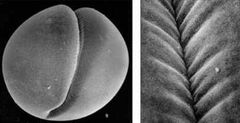
What is this an image of? |
The cleavage furrow of a fertilized frog egg. |
|
|
What causes the cytoskeleton to collapse before cytokinesis? |
1. Microtubule-associted proteins (MAPs) are phosphorylated. 2. Integrins, which hold cell to the substratum (whatever surface the cell is on), are phosphorylated and weaken their grip. This causes the cell to become more rounded rather than flat. |
|
|
What causes the cytoskeleton to reform after cytokinesis? |
1. MAPs are de-phosphorylated. 2. Integrin contacts with substratum reestablish, causing the cell to flatten out again. |
|
|
What is apoptosis? |
Programmed death of individual cells. This occurs to 200-300B cells/day in humans. |
|
|
What is necrosis? How is it different from apoptosis? |
1. Necrosis occurs when a cell is damaged or injured. The cell lyses (breaks open), and the contents spill out. 2. Apoptosis occurs when cell organization breaks down deliberately |
|
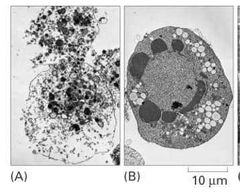
What is this an image of? |
Left is a cell undergoing necrosis. Right is a cell undergoing apoptosis. |
|
|
What is a way to clear out apoptotic cells? |
Phagocytosis engulfment. |
|
|
What are the functions of apoptosis? |
1. Development 2. Response to un-repairable DNA damage. |
|
|
Give an example of apoptosis caused by development. |
The metamorphosis of a tadpole into a frog. Cells in the tail, for example, are programmed to die to form a frog. Formation of digits in a mouse embryo is another. Basically the loss of cells in order to develop final structures. |
|
|
What are the major events in apoptosis? |
1. The cytoskeleton collapses, and the cell shrinks. 2. Chromatin condenses and localizes to edge of nucleus, nuclear lamina collapses, and nucleus fragments into vesicles. 3. Chromosomes are digested into approx. 200bp fragments 4. Phagocyte's (immune cells) recognize cell surface signals and engulf apoptotic cell, eventually digesting it completely. |
|
|
How do survival factors affect apoptosis? |
They suppress it. Animal cells need signals from other cells to survive. For example, many types of nerve cells are produced in excess in the developing nervous system and then compete for limited amounts of survival factors secreted by target cells they contact. Nerve cells that receive enough survival factor live. Those that don't die by apoptosis. |
|
|
What is BDNF |
Brain-derived neurotrophic factor. It is a survival factor released by target cells for neurons. |
|
|
How does unrepaired DNA damage induce apoptosis? |
1. DNA damage triggers activation of p53 protein, halting cell at end of G1 phase. 2. Bcl2 family of intracellular proteins Bak or Bax are activated if the damage can't be repaired. Aggregate in outer mitochondrial membrane. 3. Aggregation causes release of cytochrome c into mitochondrial intermembranespace, which is released in the cytosol. 4. Cytochrome c binds to adaptor protein, causing it to assemble into a 7 armed complex. 5. Complex recruits procaspase-9 molecules (seeds of destruction). Forms the apoptosome. 6. Procaspase-9 activates, then activates executioner procaspase in cytosol. 7. Results in a caspase cascade, leading to apoptosis.
Intrinsic pathway, meaning activated internally. |
|
|
How can neighboring cells trigger apoptosis? |
Several ways, but the best understood involves the death receptor Fas.
1. Fas ligands on killer lymphocytes activate Fas receptors on the surface of a target cell. 2. Triggers assembly of a collection of intracellular proteins to form death-inducing complex (DISC), which includes procaspase 8 or 10. 3. Procaspases cleave and activate one another to produce active caspases. 4. Executioner procaspases activate in cytosol, leading to caspase 8 or 10 proteolytic cascade and apoptosis. Extrinsic pathway, meaning activated externally. |
|
|
What are the functions of caspases? |
1. Caspase 8 and 9 are initiator caspases. They cleave, and thereby activate, the cascade of other caspases (executor caspases, approx. 7 in all) to amplify cellular response. 2. Degrade key cytoskeleton proteins (lamins, MAPs, etc). 3. Activate DNAse, which degrades chromosomes into very small fragments. |
|
|
What are procaspases? |
Inactive precursors to caspase enzymes. |
|
|
How are procaspases activated? |
Two inactive molecules are bound together. To activate, the NH2 at their ends are cleaved. The rest assembles (dimerize) into one active caspase molecule. |
|
|
Describe the caspase cascade. |
Each activated initiator caspase can cleave many executioner procaspases.
Ex: active caspase 8 activates caspase 3 (cleaves nuclear lamins), which activates even more caspases (2, 6, 10, which cleave MAPs and other cytosolic proteins) in an exponential fashion. Once this starts, it is irreversible. |
|
|
What is the difference in chromosome segregation between meiosis and mitosis? |
Mitosis: homologous chromosomes line up at Metaphase plate independently. Meiosis I: homologous chromosomes (maternal and paternal copies) are paired at the Metaphase plate. Called homologous pairs. |
|
|
What is a bivalent chromosome? |
Homologous pairs held together. |
|
|
How are bivalent chromosomes held together? |
1. Recombination links homologs 2. Synaptonemal complex (SC): A protein structure that holds homologs together along their entire length until the end of prophase I. |
|
|
What is the chiasma? |
The physical structure formed when non homologous pairs cross over (genetic exchange). |
|
|
How many cell division cycles does meiosis have compared to mitosis? |
Meiosis: Two. A diploid germline cell's DNA duplicates, leaving 4 copies of each chromosome. Two rounds of segregation result in four gamete daughter cells that are haploid.
Mitosis: One. Diploid somatic cell's DNA replicates, resulting in 4 copies of each chromosome. One round of segregation results in two diploid somatic daughter cells. |
|
|
What determines if a haploid germline cell will be an egg or sperm? |
Gender of the parent. |

